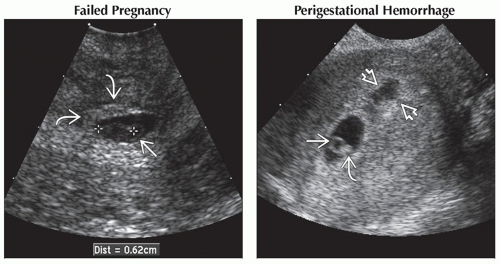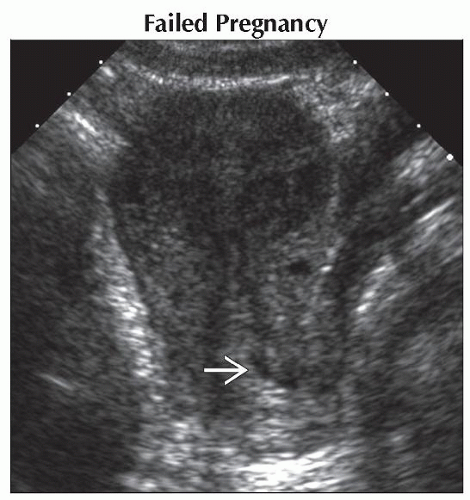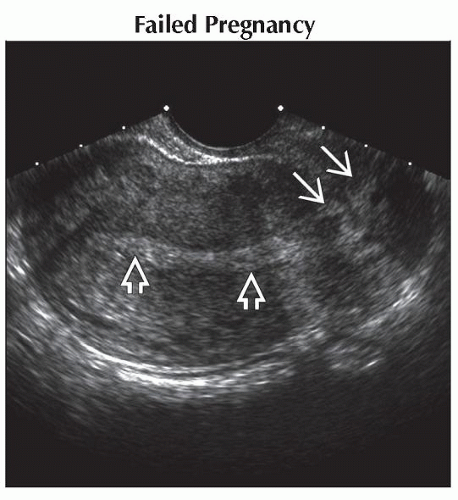Bleeding With IUP
Anne Kennedy, MD
DIFFERENTIAL DIAGNOSIS
Common
-
Failed Pregnancy
-
Perigestational Hemorrhage
-
Early Normal Pregnancy
-
Anembryonic Pregnancy
Less Common
-
Partial Mole
-
Twin Demise
Rare but Important
-
Interstitial Ectopic
-
Cervical Ectopic
-
C-section Scar Ectopic
-
Heterotopic Pregnancy
ESSENTIAL INFORMATION
Key Differential Diagnosis Issues
-
Is there a gestational sac?
-
Imperative to differentiate a normal early gestational sac from a pseudosac seen in ectopic pregnancy
-
If no intrauterine pregnancy (IUP) look for adnexal mass, echogenic fluid in cul-de-sac
-
-
Where is the sac located?
-
Compare to prior studies if available
-
-
Has there been appropriate interval development?
-
Must know normal developmental milestones
-
-
Normal sac development
-
Intradecidual sac sign (IDSS) earliest sign of IUP
-
IDSS seen by 4-4.5 weeks after last menstrual period (LMP)
-
Gestational sac “burrows” into endometrium
-
Echogenic ring is eccentric to linear interface of endometrial surfaces
-
Must follow to confirm appropriate growth/milestones
-
-
Double decidual sac sign (DDSS) seen by 5-5.5 weeks post LMP
-
Initially described as first reliable transabdominal sign of IUP
-
Decidua parietalis (endometrium) surrounds decidua capsularis (gestational sac) = two echogenic rings
-
-
-
Pseudosac associated with ectopic pregnancy
-
No DDSS
-
Flatter shape than normal gestational sac
-
Central in cavity rather than eccentric
-
-
Even if normal IUP seen beware heterotopic pregnancy if patient symptomatic/has risk factors
-
Placenta previa/abruption are NOT first trimester diagnoses
-
Placenta often covers internal os in first trimester
-
Placenta large relative to uterine size
-
Lower uterine segment (LUS) elongates after 28 weeks
-
Placental trophotropism results in migration of placenta away from cervix/LUS as pregnancy progresses
-
Helpful Clues for Common Diagnoses
-
Failed Pregnancy
-
Cardiac activity will be absent
-
Sac being expelled from uterus, may contain yolk sac or embryo
-
Sac often flattened/irregular shape
-
Sac in endometrial/cervical canal not implanted into uterus
-
Color Doppler shows lack of normal trophoblastic flow
-
-
Perigestational Hemorrhage
-
May be asymptomatic or present with vaginal bleeding
-
Echogenic fluid deep to chorion
-
Becomes hypoechoic over time
-
-
Normal gestational sac contents
-
-
Early Normal Pregnancy
-
Bleeding in pregnancy before visualization of gestational sac (presumed to be implantation bleeding)
-
Follow all apparent IDSS to ensure normal developmental milestones
-
Beware tiny cystic structures in endometrium, may be dilated endometrial glands
-
-
Idiopathic bleeding: Normal sac/embryo seen but no obvious collection of blood
-
-
Anembryonic Pregnancy
-
No visible embryo in gestational sac with diameter ≥ 18 mm by transvaginal exam
-
Look for “empty amnion” sign
-
Helpful Clues for Less Common Diagnoses
Helpful Clues for Rare Diagnoses
-
Interstitial Ectopic
-
Look for interstitial line sign
-
Eccentric placement of sac in relation to uterine cavity
-
< 5 mm of surrounding myometrium very suggestive
-
-
Cervical Ectopic
-
Sac implanted in cervical stroma
-
Look for rim of tissue around sac rather than sac within endocervical canal
-
Sac positioned low in uterus but still perfused (compared to abortion in progress with flattened sac, lack of perfusion)
-
-
C-section Scar Ectopic
-
Gestational sac implants into scar from prior C-section, extends to serosa
-
-
Heterotopic Pregnancy
-
Intrauterine & ectopic pregnancy
-
Look for adnexal mass, echogenic fluid in addition to IUP
-
Differential: Normal IUP with hemorrhagic corpus luteum
-
-
Risk factors for heterotopic pregnancy
-
Assisted reproduction
-
Intrauterine contraceptive device
-
History of pelvic inflammatory disease
-
History of endometriosis
-
-
Other Essential Information
-
Important to recognize unusual (other than tubal) ectopics
-
Pregnancy is “in uterus” but not in correct place
-
C-section scar ectopic treated with systemic methotrexate or percutaneous injection
-
Risk of torrential bleeding/emergent hysterectomy if curettage attempted in cervical ectopic
-
Interstitial ectopic also best treated conservatively if patient stable
-
Alternative Differential Approaches
-
Bleeding with intrauterine sac but no fetal pole
-
Anembryonic pregnancy
-
Pseudosac from ectopic pregnancy
-
Perigestational hemorrhage
-
-
Bleeding with an embryo
-
Perigestational hemorrhage
-
Idiopathic (no obvious collection of blood)
-
-
Bleeding with no visible IUP
-
Very early normal pregnancy
-
Complete abortion
-
Tubal ectopic pregnancy
-
Image Gallery

(Left) Sagittal transvaginal ultrasound in the same case “zoomed” on the cervical area shows the collapsed gestational sac
 containing a 6 mm dead embryo (calipers) and a yolk sac containing a 6 mm dead embryo (calipers) and a yolk sac  . This spontaneously passed shortly after the exam. (Right) Sagittal ultrasound shows an IUP with a yolk sac . This spontaneously passed shortly after the exam. (Right) Sagittal ultrasound shows an IUP with a yolk sac  and embryo and embryo  . There is an adjacent perigestational hemorrhage . There is an adjacent perigestational hemorrhage  . This pregnancy failed. . This pregnancy failed.Stay updated, free articles. Join our Telegram channel
Full access? Get Clinical Tree
 Get Clinical Tree app for offline access
Get Clinical Tree app for offline access

|




